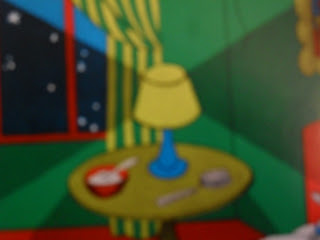Much of the job is based on luck, sometimes it's all in the timing (bones and brains around halloween= easy, the same bones and brains in June= frusterating, the same goes for other holiday decorations, outdoor toys, fake seasonal flowers and any other number of things you might never have realized stores only carry seasonally).
There is an unending number of skills you'll be asked to have; carpentry, sewing, upholstery, sculpting, painting, graphic design, puppetry, rigging and many others. It can get discouraging when you are expected to be a master of all these things, and are continually being confronting with another skill you need to learn.
By far the worst things though, and the one that leads to the most frustration and burn-out, is cuts and changes. Unlike scenery, which can be difficult to change once it is built, props are pretty easy to change, so they will get changed. Often. They will also get cut. Often. Remember this beautiful rug that took Katy almost three full days of work to braid, coil and glue. They were worried about one of the rolling set pieces getting caught on it, so they decided it should be painted instead. The choice makes sense, and I agree.
This situation was sort of best scenario. Katy doesn't care too much as long as she gets paid, and I don't feel like my time was wasted. I am a little frustrated because I have plenty of other things I could have used Katy's help on, and would have been in a much better position going into tech if she hadn't spent her time on the rug, but overall I was able to pretty easily brush it all off and move on.
And to add an even happier ending, I pulled the artistic director backstage during previews, unrolled the rug and asked her if there was any way to use it. They are currently using it under all the little tables and chairs they have set up in the lobby with coloring books for the kids prior to the show, so at least someone is enjoying it (even if it is being quickly destroyed by being trampled by dozens of muddly little shoes each weekend).
And to add an even happier ending, I pulled the artistic director backstage during previews, unrolled the rug and asked her if there was any way to use it. They are currently using it under all the little tables and chairs they have set up in the lobby with coloring books for the kids prior to the show, so at least someone is enjoying it (even if it is being quickly destroyed by being trampled by dozens of muddly little shoes each weekend).


































